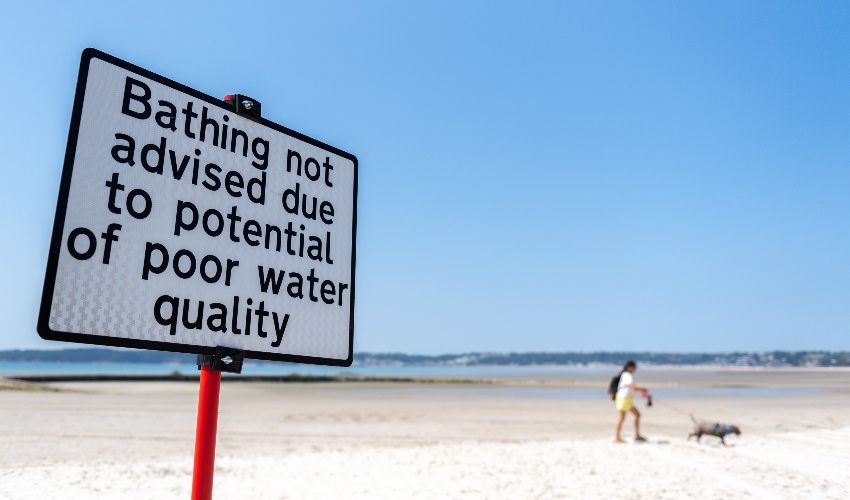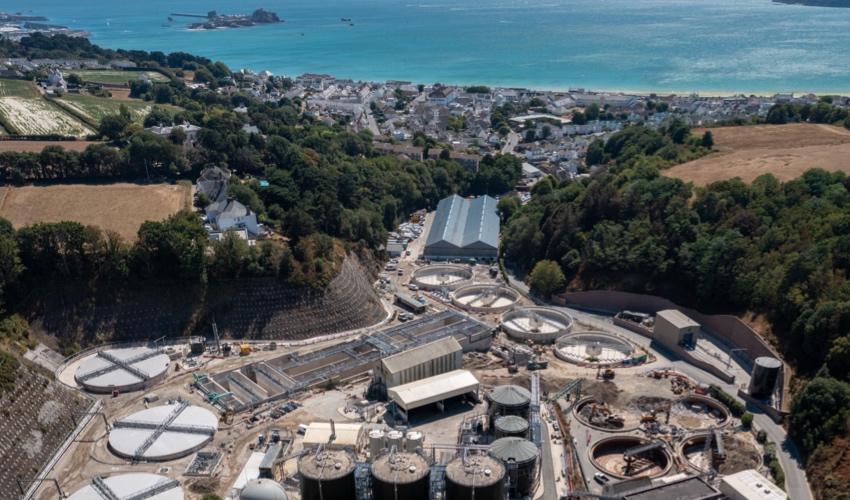


Islanders are being urged to take more care during their cooking clean-up following concerns that high levels of fat in the drainage network may have been partially responsible for a "blip" at the new £83m Bellozanne plant which led to under-treated sewage to flow into St. Aubin's Bay.
'No-swim' advice was issued on 14 June when officials from the Infrastructure and Environment Department first became concerned about the quality of the water in the area, where the Sewage Treatment Works discharges.
Testing of an undiluted sample showed the quality of the water to be "poor" by EU Standards due to the volume of e.coli (an illness-causing bacteria). However, testing of a 'bathing water' (diluted) sample later in the week saw quality return to "excellent", allowing the Jersey Triathlon to go ahead.
An investigation into a potential breach of the Water Pollution (Jersey) Law 2000 was subsequently opened. Water pollution incidents can carry an unlimited fine.
Officers told Express yesterday that the problem had arisen as a result of a “blip” in the treatment process – possibly prompted by a long period of dry weather but also high levels of fat in the sewage network.
The Government is now writing to the hospitality trade and reminding households of the importance of correctly disposing of oils and fats, such as wiping away leftover grease or fat from pots and pans with a paper towel before washing and rinsing.
Head of Liquid Waste Duncan Berry added that the department was also tweaking the new plant, which is now treating all sewage in the island.
Video: Outflow in St. Aubin's Bay at the time of the incident.
“We are still getting to grips with the new plant but I suspect this blip would have happened regardless,” he said. “We went slightly over our consented levels due to high levels of fats and ammonia, which upset the process.
“Fats cause blockages in the network and, in the plant, it causes solids to rise in the process tanks, which hampers the ultra-violet treatment.
“With more solids, UV cannot penetrate as far as it should, and you get higher biological loading."
The smell of ammonia is putrid at the end of First Tower sewage pipe tonight . The sea is literally full of green mulch only here @ITVChannelTV @BBCJersey @JEPnews Yet SOJ claim it’s all ok. Not a great look for locals and tourists to swim in pic.twitter.com/KGqU8z0CNe
— Matthew (@matthewhowe69) June 21, 2023
Pictured: One islander reported on Twitter that he had observed lots of "green mulch" and that the smell of ammonia was strong in St. Aubin's Bay in the week after the incident.
He added: “The level of fat is something all islanders can help us reduce with a bit of care when washing up.
“We are trying to find out the source of the ammonia. It might be due to high nitrates prompted by a long period of dry weather which affected the inward flow.”
Mr Berry said he was confident that the new plant, once fully up and running, would improve the cleanliness of effluent, although its main advantages were increased capacity and a reduction in operating costs due to better technology.
Operating and maintenance costs are expected to fall by a third.

Pictured: The new sewage treatment works at Bellozanne, which is expected to be fully operational by the end of the year.
“The old facility opened in 1959 and was at the end of its technological life,” he said. “The new treatment works is designed for a population of 142,000 people and now it is close to being fully operational, we can focus on the sewage network to make sure we can get the flows into Bellozanne for treatment.
“Before, we could treat 600 litres a second, but now it is 840 litres a second.”
Mr Berry added: “And previously, in times of heavy rainfall, we were filling the cavern at Snow Hill and occasionally releasing partially treated effluent.
"Now we have our own mini-cavern at Bellozanne so we are able to fill that tank first before the main cavern.”
Video: The journey from the cavern entrance in Snow Hill car park into the main chamber.
He said that the plant should also reduce the amount of sea lettuce in the bay by cutting nitrate emissions by 15%.
However, he stressed that the Bellozanne outfall was not the only source of the group of chemicals.
“The whole of the Bay of Mont Saint Michel has experienced the same problem,” he said. “But the new plant does release less nitrogen and we are also working with farmers to reduce it across the board.”
Since 2021, the building and commissioning of the treatment works has been managed by Infrastructure and Environment after the main contractor NMCM went into administration.
The Government was able to retain many of the key people on the project, meaning that the collapse of the firm did not cause a significant delay.
Recently, the Government published its Bridging Liquid Waste Strategy, which sets out a programme of more than £34m of work to upgrade the island’s sewerage network.
Comments
Comments on this story express the views of the commentator only, not Bailiwick Publishing. We are unable to guarantee the accuracy of any of those comments.